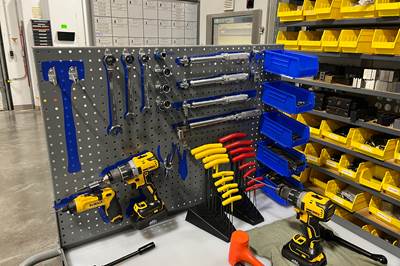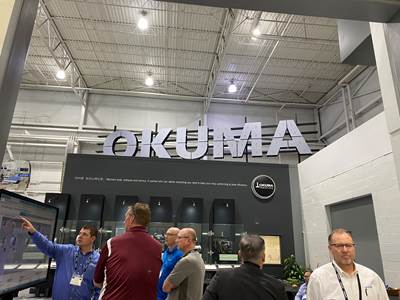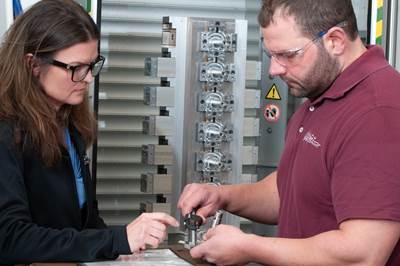Shop “Dims the Lights” With Pallets and More
Adding pallet systems brought Mach Machine success and additional productivity. The shop has since furthered its automation goals while adding new capabilities.
Share





Dan and Angela Olsen founded Mach Machine and have operated it for twenty years. Over that time, the enterprise has grown from a website for custom boat anodes to a full-fledged manufacturer serving markets from aerospace to marine to medical. Image courtesy of Fastems LLC.
Thriving in the modern manufacturing market requires an ability to know when to expand into new markets and when to refine processes for existing markets. Hudson, Massachusetts-based shop Mach Machine and its founder, Dan Olsen, have been fortunate in this regard, seeing massive success after adopting a linear Fastems Flexible Pallet Center (FPC) in 2016. Since then, the shop has used this success to springboard into automation for high-volume and repeatable jobs — with the recent purchase of a Fastems Flexible Pallet Tower (FPT) furthering this goal. But this hasn’t been the end of Mach Machine’s growth, with the shop on the cusp of several new capabilities.
From Internal Resource to Production Machining
Mach Machine began as a distribution website for anti-corrosion anodes for recreational and commercial boats. Dan Olsen soon found that most shops he spoke with were unwilling to produce the dies necessary for low-volume custom anodes and decided to teach himself how to machine these dies. From there he started taking on more customers and eventually formally founded a machine shop to handle the increase in demand.
At the start of its life, the shop’s primary machines were three-axis vertical machining centers equipped with custom indexing trunnions for fourth-axis positioning capability. These were able to handle the shop’s workload for a time, but the low-mix, low-volume work presented thin profit margins and spurred Olsen into looking for inefficiencies. After discovering that one recurring, monthly part took four hours to set up, he began looking into horizontal machining centers, reasoning that tombstones would enable the shop to build setups once and not need to worry about them again. During this search, an Okuma representative demonstrated an HMC attached to an FPC.
Olsen quickly realized the utility of the automated pallet system and purchased an Okuma MB 5000 integrated with a 12-pallet FPC. This greatly affected not just setup times, but the cycle times of many parts as well. Cycle times for a laser lens mount dropped from 24 minutes per part to 10, even as part-to-part repeatability increased. This cell originally produced parts of both aluminum and stainless steel, but difficulties emerged from the need to clean out chips and separate them depending on the material. Before long, Mach Machine doubled the size of the FPC and integrated a second Okuma MB 5000, dedicating one machine to aluminum parts and the other to stainless steel.
The increase in productivity spurred by these machines enabled Mach Machine to swiftly grow, and now the shop uses turning, single- and multi-axis mills, and turn-mills to complete its tasks. Olsen says that most of its customers have parts with long life cycles and minimal revisions, and tend to search for suppliers who are both flexible and reliable. The shop works hard to create production plans where it only needs to touch the part once during the machining step, and it performs secondary processes such as plating, painting and assembly in-house.
Orders have climbed with productivity, and to continue meeting its customers’ needs in a timely manner, Mach Machine recently installed another automation cell, this one consisting of a second-generation Okuma MB-5000H and a Fastems FPT-500.
Pallet Particulars
The Fastems FPT-500 is a compact system configurable with between two and four storage levels that hold up to six pallets each. Olsen says the shop landed on a three-tier model that could hold tombstones which leverage the full work envelope of the Okuma MB-5000H while taking up as little floor space as possible.
Despite being paired with the same kind of machine as the FPC, Olsen says the systems aren’t really comparable. Okuma revised the design of the machine tool between generations, and the new models have substantially increased the coolant flow to improve chip evacuation, while the B-axis is more rigid and the work enclosure is slightly larger. Although the machine work enclosure is larger, the work envelope for the pallets on the paired compact FPT is smaller, with a 630-mm (24.80”) diameter envelope for 500-mm pallets. For each new setup Mach designs for the system, the shop verifies that the setup fits inside a 630-mm diameter circle so it can move through the FPT without issue.
Olsen says this smaller size lowers the maximum diameter of rotation for which the shop can plan, making the FPT better for smaller parts than the FPC. All the same, Olsen says both systems can handle larger, heavier jobs than the shop’s vertical machines, and the Okuma machines can run at speeds and feeds unfeasible in the VMCs. It also helps that the Mach Machine team designs and builds tombstones in-house to fit as many parts onto the tombstones as possible while pushing the machines’ capabilities.
These tombstones (and those for the FPC) can include more than one part number per tombstone. Programming for these tends to consist of a “master program” with subprograms for each part. Olsen says this simplifies programming for future changes and modifications. The shop also uses some permanent, job-specific pallets it loads into the system whenever an order for the corresponding recurring part arrives.

Mach Machine is diligent about tracking cutting information, performance and quality. It recently upgraded its metrology capabilities with a 1,000-square-foot inspection room capable of fitting general-use CMMs and specialized equipment for demanding parts like helicoils. Image courtesy of Mach Machine.
Collecting the Data
This command and others go through Fastems’ Manufacturing Management Software (MMS) for both the FPC and the FPT. At its core, Fastems MMS manages the program and tooling libraries for the machines attached to each automated system. It automatically prioritizes jobs based on due dates, part numbers, quantities and other information Mach Machine puts in, and has been doing so since Mach Machine purchased its first automated cell. The newer version isn’t so much a wholly different piece of software as it is a usability-focused refinement.
Olsen says the way the new version of MMS presents data is more useful, with graphical views that make it easier to view capacity limits and other data. The version of MMS that came with the FPT also uses a touchscreen, which Olsen says makes interacting with the software much simpler. He also says the new system makes editing fixtures and parts much easier.
Where both versions of the software most stand out for Mach Machine, however, is in their ability to assist with production planning. The system has enabled the shop to “dim the lights,” as Olsen refers to the shop’s preparations for lights-out automation. The Mach Machine team pushes its tools just as hard as its pallets, testing them to know how far they can go in terms of feeds, speeds and any other metrics that affect tool life and part quality. After capturing this data, the shop feeds it into Fastems MMS and uses the information to set tool life. When tools near the end of their life and are unable to finish a job, the system alerts operators to replace the tool. The system also tracks tool load and inconsistencies, halting the production process in response to odd readings to prevent errors.
Olsen says that these features are particularly useful for jobs involving stainless steel and harder alloys, enabling the shop to maintain its high yield even with these more difficult materials. The software also supports drag-and-drop planning for when Mach Machine wants manual control, alerting users whenever there is a conflict.
Automation Beyond Pallets
Drag-and-drop production planning simplifies matters when scheduling jobs for some of the shop’s repeat customers. Mach Machine has linked its ERP with those of its largest customers to enable electronic updates of blanket purchase orders, and the shop also monitors customer inventory levels so it can proactively build parts to fulfill orders. These jobs make up a large portion of the FPC’s work.
For the really high-volume jobs, the shop also uses a few other automation systems. It has paired an Okuma LB3000 mill-turn with an Okuma OGL10 overhead gantry loader, a combination Olsen describes as a little slower than the horizontal machines in terms of cycle time, but ultimately more productive due to its ability to store more raw material in the system. The shop also takes a different approach for delicate parts, pairing a UR10 cobot with an Okuma lathe to unload the parts rather than risk damage in a parts catcher.
Mach Machine is also taking its first steps into Swiss-type work. Olsen says learning how to use its first Swiss machine was a challenge, but that it has been excellent for repeating jobs since coming online.

Mach Machines’ Fastems flexible manufacturing systems and Okuma machines handle most of its production work, but the shop is also looking into diversify its capabilities to improve its resilience against downturns in any one market. In particular, the shop is looking to expand its burgeoning Swiss machining and wire EDM areas. Image courtesy of Mach Machine.
New Specialties
Swiss isn’t the only area of growth for Mach Machine, however, with the shop taking steps into several other areas.
To coincide with the start of operations for a 1,000-square-foot inspection room the shop created as part of a recent expansion, Mach Machine is developing use-specific metrology areas. While the room will play host to several CMMs and assembly benches, Olsen points out that helicoils and other specialty products require specialty inspection equipment — and that this expansion gives it more room for these dedicated devices. The shop is also preparing for CMMC 2.0. Olsen says his team is dedicated to ensuring compliance, and the shop recently scored well on a test.
Olsen and his team are also expanding into more short-run work for the three-axis and 3+1-axis VMCs. While this may seem like a contradiction with the Fastems systems, Olsen says it is just another way to diversify business and ensure financial stability when any one market experiences a downturn.
After all, the Okuma horizontal mills and Fastems systems were also once an experiment for the shop, unlocking larger, heavier jobs. These next steps are continuing this trend, meant to help the shop as it expands in footprint and regional prominence.
Related Content
CNC Machine Shop Honored for Automation, Machine Monitoring
From cobots to machine monitoring, this Top Shop honoree shows that machining technology is about more than the machine tool.
Read MoreHow to Mitigate Chatter to Boost Machining Rates
There are usually better solutions to chatter than just reducing the feed rate. Through vibration analysis, the chatter problem can be solved, enabling much higher metal removal rates, better quality and longer tool life.
Read MoreQuick-Change Tool Heads Reduce Setup on Swiss-Type Turning Centers
This new quick-change tooling system enables shops to get more production from their Swiss turning centers through reduced tool setup time and matches the performance of a solid tool.
Read MoreHigh RPM Spindles: 5 Advantages for 5-axis CNC Machines
Explore five crucial ways equipping 5-axis CNC machines with Air Turbine Spindles® can achieve the speeds necessary to overcome manufacturing challenges.
Read MoreRead Next
Translating a Prototyping Mindset to Production
The experimental mindset that benefited BDE Manufacturing Technologies as a prototype job shop has given it an adaptable edge as a production facility.
Read MoreOkuma Demonstrates Different Perspectives on Automation
Several machine tools featured at Okuma’s 2023 Technology Showcase included different forms automation, from robots to gantry loaders to pallet changers.
Read MoreHorizontal Machining Plus Automation Prove to Be a Rewarding Investment
After watching a machinist take four hours to set up a part on a VMC, Dan Olsen of Mach Machine knew he had a problem. The solution seemed clear: horizontal machining. The automation system wasn’t expected; but the novelty was well worth it before long.
Read More































